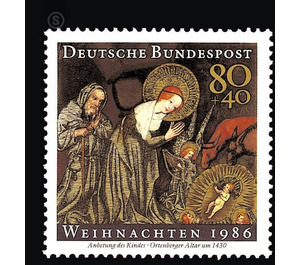Christmas - Germany / Federal Republic of Germany 1986 - 80 Pfennig
| Country | Germany / Federal Republic of Germany |
| Issue Date | 1986 |
| Face Value | 80.00 |
| Color | multi-colored black |
| Perforation | K 13 3/4 |
| Printing Type | Six-color offset printing |
| Stamp Type | Postage stamp |
| Item Type | Stamp |
| Chronological Issue Number | 1176 |
| Chronological Chapter | GER-BRD |
| SID | 219607 |
| In 34 Wishlists | |
The Ortenberg altar, built around 1430, is one of the most important works of Gothic painting. However, as is almost always the case with paintings of this period, the artist is not known by name. The painter is named "Master of the Ortenberg Altar" after his major work. He was active in the first quarter of the 15th century, he probably had his workshop in Frankfurt or Mainz. He probably also made designs for stained glass. The altar, more precisely the altarpiece or the retable, is of the type of a winged altar. It consists of a 162 cm wide and 100 cm high center panel and two half as wide movable wings. The wings are painted in contrast to the center panel inside and outside. Particularly striking is the effect of the altar in the open state, so the Festtagsseite, the community was shown only a few high holidays. On the middle panel, placed in two rows one above the other, the Holy Family with its female relatives, the cardinal virgins Barbara, Agnes and Dorothea as well as St. Servatius are reproduced. The multi-figured, complex representation pays tribute to the virginity of Mary. The side wings each show an event from the life of Mary, but the Christ Child is in the center. On the left wing is the adoration of Jesus by Mary, on the right the adoration of the child by the Magi. The garments of almost all figures are not painted with color, but designed with a fine silver foil. Contours and garment folds are indicated by thin black lines. A wafer-thin, yellowish coat of paint protects the silver from oxidizing and becoming unsightly black. At the same time, the yellow glaze makes the silver shine golden and yet shine differently than the parts actually worked with gold foil, such as the halos or the sky. The artistic sources are in the so-called "soft style", which was widespread in 1400 throughout Europe - depending on the artistic landscape differently shaped. The soft style of the Ortenberger Altar, for example, is characterized by the soft style, the soft flowing garments and the realistic details. The altar comes from the Ortenberg parish church. In 1864, the community had worshiped him the then Grand Duke of Hesse, after he had expressed his pleasure in the play. From the Grand Ducal collection, the altar came to the Hessian State Museum Darmstadt. Probably it was originally painted for the Ortenberg church. The site is assumed to be the east wall of the southern aisle. The founder of the altar is a member of the Eppstein family. The lords of Eppstein were around 1420 not only the most important princes in the Rhine-Main area. They also held most of the rule over Ortenberg and also the patronage of the parish church. The painting on the left wing of the Ortenberg altar fully corresponds to our idea of a "Christmas picture". But the story of the birth of Christ, as she tells the Bible and the art has represented over centuries, just does not show the picture. For, like other painters of his time, the master of the Ortenberg altar breaks with the tradition of reproducing Maria as a woman in a wc in an interior. His form of representation goes back to a vision of Brigitta of Sweden (1303 - 1373). According to this vision, after birth, Christ lay upon a bundle of hay at the feet of his mother, surrounded by rays "brighter than the sun." Mary and Joseph knelt down and worshiped the boy. This picture narrative, which is also used by the master of the Ortenberg altar, prevailed in the following period and became the popular "Christmas picture". (Text: Hessisches Landesmuseum Darmstadt)


